Please Note- this website is best viewed on a desktop/laptop as it is not mobile-friendly. I am working on trying to convert it!
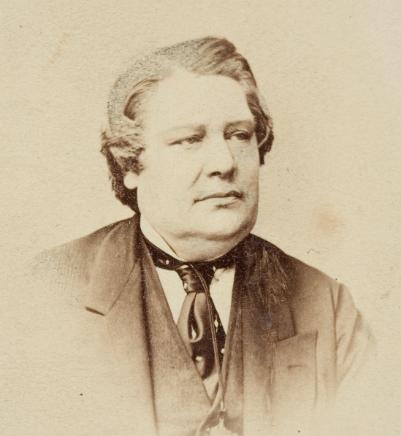
Images courtesy of Bristol Museum and Art Gallery
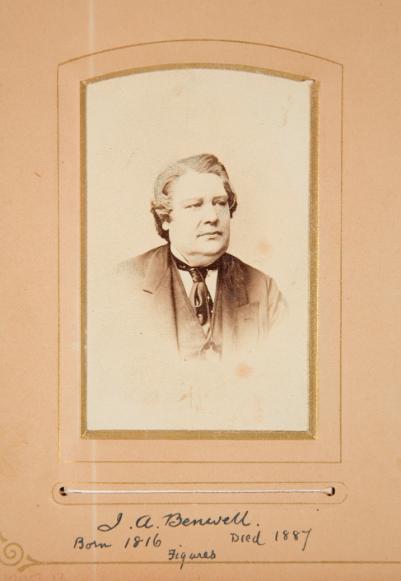
Biographical Notes
Joseph Austin Benwell was born on 26 May 1816 at 35 Canterbury Square, Southwark, London, the second son of Joseph Benwell, an accountant, and his wife Charlotte. His birth was recorded in the ‘Register of Births belonging to the Monthly Meeting of Gracechurch Street, London from 1793 to 1837 TNA Reference RG6 / Piece 415'.
His family had been active in the Society of Friends, or Quaker, movement since the late 17th century in Berkshire and later in Somerset and Bristol. His father Joseph was born in Yatton, Somerset, but the family resided for some years in London between about 1810 and 1824, where several children were born, before moving back to the Bristol area. Joseph Austin Benwell’s paternal grandfather, John Benwell, was the founder of Sidcot, the Quaker school in Somerset on its re-establishment in 1808, and was the author of the posthumously-published diary ‘Extracts from a Diary kept by the late John Benwell of Sidcot...’ (1825). Find out more about Joseph Austin Benwell's family history.
Key dates from records:
Born 26 May 1816, 35 Canterbury Square, Southwark, London
1830s - working in the office of Jacob Sturge, Clare Street, Bristol (Land Agents and Surveyors)
Not found in the 1841 census - travelling abroad in 1840s to 1850/51
1840s - (and possibly earlier) entered the service of the East India Company, residing in Calcutta and Burma.
1851 - staying with/visiting parents Joseph and Charlotte Benwell after return from India, at Clifton, Bristol (1851 Census)
Early 1850s - set up partnership with George Frederick Bonner as Designers, Lithographers and Wood Engravers in London.
1853 - Partnership with George Frederick Bonner dissolved 1 February 1853 (London Gazette)
1854 - married Marian Boulton 13 July 1854 at St George, Bloomsbury, London
1855-56 - resident at 27 Frederick Street, Gray’s Inn Road, London ('The Publishers' Circle' and 1856 Post Office Directory)
1857-59 - trip/s to India, and working as an artist for the Illustrated London News (Benwell's engravings were regularly published in the Illustrated London News between 1857 and 1864). In an article in the ILN published 25 December 1858 Benwell (“our Artist”) described his adventures and experience of Dawk travelling between Calcutta and Benares.
1856-58 - home address 14 Ampton Place, Gray’s Inn Road. London (Modern English Biography, The Athenaeum, and letter dated 2 June 1857 to Royal Literary Fund)
1860 - resident at 3 Raleigh Villas, Canonbury Park North, London (letter dated 31 May 1860 to Royal Literary Fund and Post Office London Directory)
1861 - resident at 6 Crescent Road, Canonbury Park North, in Finsbury, Islington, London (1861 Census)
1862 - resident at 12 Alma Road, Canonbury Park, London (letter dated 2 July 1862 to Royal Literary Fund)
1863-64 - travelling in the Middle East (early Orientalist-style watercolour painted and dated 1864, Illustrated London News article 27 August 1864 refers to his ‘recent’ visit to Tunis and Egypt)
1865 - resident at 25 Victoria Grove, Kensington, London (Post Office London Directory)
1865-68 - resident at 7 Sussex Place (known as Launceston Place since 1883), Kensington, London (Royal Academy records) and 'Works Exhibited at the Royal Society of British Artists 1824-1893' (Johnson)
1865-66/7 - travelling again in Egypt, Palestine and the Near/Middle East?
1865-80 - Exhibited at the Royal Academy
1868/69-70/71 - resident at 5 Upper Gore, Kensington, London (Royal Academy records)
1869 - elected member of the Society of Arts, 28 April 1869 (Journal of the Society of Arts vol 17, 30 April 1869, p 440)
1871-72 - resident at 44 Montpelier Street, Kensington, London (1871 Census and Official Catalogue of the 1871 International Exhibition)
1872/3-77 - resident at 5 Hedgerley (Hedgeley) Park Terrace, Turnham Green, Chiswick, London (London Electoral Registers, 1835-1965 and catalogue for the London International Exhibition 1873/ '
1877/8-86 - resident at 13 Abingdon Villas, Kensington, London (1881 Census and Royal Academy records, and 'Webster's Royal Red Book: Or, Court and Fashionable Register', 1880s editions and Post Office London Directory)
Died 13 May 1886, Abingdon Villas, Kensington, buried at Kensal Green Cemetery, May 1886
Catalogue notes on a 1908 exhibition at Bristol Art Gallery state "Joseph A Benwell was born in 1816, his father being a well-known Quaker. He was at one time in the office of Jacob Sturge, Clare Street, Bristol.” The Sturge family were also long-standing Quakers, who ran JP Sturge and Sons the firm of Land Agents and Surveyors in Bristol which dated back to about 1760. So we know this was Benwell’s occupation as a young man before he became an artist. Benwell’s grandfather, John Benwell (1749-1824) was the headmaster of the Quaker school at Sidcot. Among his pupils were Joseph Sturge (1793-1859), philanthropist and abolitionist who founded the British and Foreign Anti-Slavery Society. Another pupil was Joseph’s cousin, Jacob Player Sturge, described as ‘the eminent land surveyor’. John Benwell wrote of Jacob in a letter to his father in 1803- “Sidcot, 6th month, 7th, 1803. Esteemed Frd., I am sorry to part with Jacob as he has been a good boy, and has improved, I think, considerably in his learning. Few lads of his age appear to have a clearer knowledge of figures; he also has a tolerable idea of grammar, and seemed to be getting into the knack of writing free.” From “A Mendip valley, its inhabitants and surroundings, being an enlarged and illustrated edition of Winscombe sketches” by Theodore Compton (1892). The Benwells and the Sturges obviously had quite close connections.
Joseph Austin Benwell married Marian Boulton (1821-1892), also an exhibiting artist (see below), in Bloomsbury on 13 July 1854. There are no records to date of any surviving children or descendants.
Various sources (refer below) give limited information about his travels. Joseph Austin Benwell entered the service of the East India Company in the 1840s. Sources indicate he travelled to India and China before 1853, and was resident in India for a while "prior to 1856/57". He was definitely in England in 1851, as the census records him as being at his parents' house in Clifton, Bristol. His occupation on the 1851 census record was 'Artist'. His coloured lithographs of Florence Nightingale at Scutari, 1855 (Constantinople) and a Crimean battle scene ‘The Heights of Alma- the Day after the Battle, 20 Sept 1854’ indicate he may have travelled overland at some stage, unless they were executed whilst he was back in England. Certainly any overseas trips made in the 1850s would have been of relatively short duration, as records indicate his presence in his home country for much of that decade. Some of his illustrations for ‘Our Indian Army’ depict battle scenes from 1839 and 1845, indicating he may have been in India quite early and possibly explaining his apparent absence from the 1841 census records.
References show that he was a resident of Calcutta (refer ‘The Sunday at Home’ 1862, page 760). An advertisement in 'The Publishers' Circle' 15 September 1855 (below left) refers to his 'long residence in the East'. He also lived in Burma - another advertisement in the 'The Athenaeum: Journal of Literature, Science and the Fine Arts’, 7 June 1856 (below right), refers to his “ long residence in India and Burmah”, most likely in the 1840s. A record from the Bengal Directory 1845 refers to a shipping departure (the Ketty) from Calcutta to Moulmein with a Mr Benwell on board, in February 1844. Moulmein was an ancient port and city and the first capital of British Burma. It is possible that this could be 'our' Mr Benwell, the dates are about right and also the route.
A notice in the London Gazette on 1 February 1853 refers to the dissolution of a partnership with George Frederick Bonner (son of George Wilmot Bonner, wood engraver) as Designers, Lithographers and Wood Engravers at 5 Bride Court, Fleet Street in London. This indicates Benwell went to London in the very early 1850s to set up in business soon after his return from India. The subsequent period between 1857 and 1863 seems to have been his busiest and most prolific with regard to production of engravings and illustrations, particularly for 'The Illustrated London News' and the publications of the Religious Tract Society.
'The Publishers' Circle' 15 September 1855
'The Athenaeum: Journal of Literature, Science and the Fine Arts’, 7 June 1856
From 1865-6 he spent time in Egypt and Palestine; he is referred to in the book ‘Under Egypt’s Spell; the influence of Egypt on writers in English from the 18th century’, by Mursi Saad El Din and John Cromer (1991). The book ‘Painting the Holy Land in the nineteenth century’ by Yehoshua Ben-Arieh (1997) refers to this part of his life after 1865 and his interest in Egypt, Sinai and Jerusalem. A short article in the Illustrated London News of 27 August 1864, accompanying his engraving ‘Tunis water-carriers’ states that he “recently visited Tunis, and thence went overland to Egypt”, maybe not the easiest way to get there! This implies he was actually travelling in 1864, earlier than some other records indicate..
'Tunis water-carriers' Illustrated London News, 27 August 1864
Another source, AgraArt states: “Joseph-Austin Benwell - English Orientalist painter, cartoonist, illustrator and graphic artist. In the years 1856 - 1887 he lived and worked mostly in London's Kensington, but he went on trips to the East. It is known that in 1856 he was in India and China, in 1865/1866 in Egypt and Palestine. Painting watercolor and, more rarely, in oil, mainly oriental themes and motifs, landscapes, people and caravans in the desert (usually with a distinctive white camel), or passing the ruins of ancient Egyptian temples.”
Joseph Austin Benwell’s entry in the ‘Dictionary of Indian Biography’ (1906) by C E Buckland reads:
“Artist: resided for some time, prior to 1856, in India: conspicuous for original and pleasing delineations of native life, landscape and buildings in India, evidently drawn on the spot: chiefly known as a draughtsman on wood of Eastern subjects, principally Indian and Chinese. Exhibited at the Royal Academy up to 1883: illustrated Capt. M. Rafter's Our Indian Army, and Capper's Three Presidencies of India: nearly all his drawings on wood are in the periodicals and journals of the 'sixties, such as the Illustrated London News, and, to about 1876, the publications of the Religious Tract Society: he illustrated also The Indian Nabob of 100 years ago, by G. E. Sargent in The Leisure Hour for 1858, a story of considerable merit of the British conquest and settlement of Bengal: he painted a series of dissolving views of Indian life, exhibited in London before 1862: his signature on drawings is usually JB but occasionally JAB.”
Benwell is also referred to in ‘Who Was Who in British India’ by John F. Riddick. Westport, CT: Greenwood Press, 1998.
Joseph Austin Benwell died on 13 May 1886 at Abingdon Villas, Kensington, and was buried at Kensal Green Cemetery, Kensington. His wife Marian was interred in the same grave in March 1892.
Extract from Websters' Royal Red Book: or, Court and Fashionable Register 1884
Extract (above) from 'Modern English Biography, containing many thousand concise memoirs of persons who have died between the years 1851-1900'' Frederic Boase. Vol iv, 1908
The 'Journal of the Royal Society of Arts' began in 1852 as the 'Journal of the Society of Arts' (see above extract). It added 'Royal' to its name in 1908, when the Society gained royal recognition.
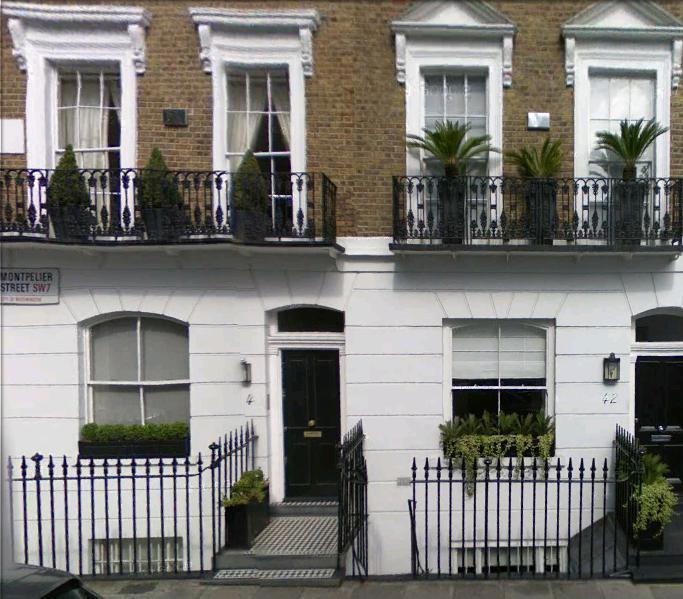
44 Montpelier Street, Kensington, London, home of Joseph Austin Benwell during the early 1870s.
"Former residents of the street include the artist Joseph Austin Benwell, a specialist in pictures of India, who was living at No. 44 in 1871, and the painter William Henry Haines, who died at No. 44 in 1884. Another artist, Frederick S. Thomas, was living at No. 32 in 1841. The Arts and Crafts architect James MacLaren lived at No. 40 with his brother Thomas, later also an architect, in the early 1880s. Dyneley Hussey, the music-critic, lived at No. 22 in the 1920s."
From British History Online: 'Montpelier Square Area: Other Streets', Survey of London: volume 45: Knightsbridge (2000), pp. 116-24.
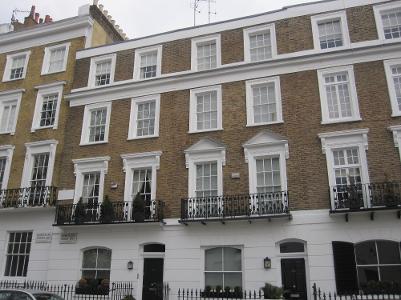
44 Montpelier Street, Kensington, London, home of Joseph Austin Benwell during the early 1870s.
25 Victoria Grove, Kensington, London, home of Joseph Austin Benwell during the mid 1860s.(photo taken c1973)
Extract from 'The Royal Academy of Arts – A Complete Dictionary of Contributors and their work from its Foundation in 1769 to 1904', Algernon Graves FSA, 1905
Extract from ‘A Dictionary of Artists who have Exhibited Works in the Principal London Exhibitions of oil paintings from 1760 to 1880’, Algernon Graves, 1884
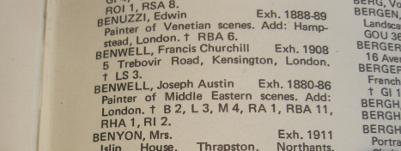
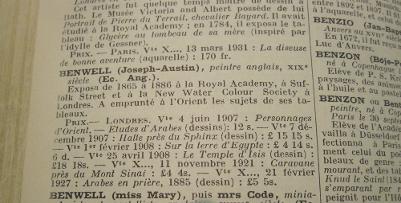
Extracts from Dictionaries of Artists held in the V&A Museum, London

Records indicate that Benwell’s wife Marian (nee Boulton) was also an artist, and it seems possible that they may have travelled together to the Middle East, more specifically Egypt. She is referred to in 'The Dictionary of Victorian Painters' by Christopher Wood (1978) (see above), alongside her husband, and exhibited at the Suffolk Street gallery of the Royal Society of British Artists. We know that she exhibited watercolours (Italy and Egypt) in the early 1870s- three of her paintings: ‘Italian Lake Scene’ (1870), ‘Isola Bella, Maggiore’ (1871) and ‘Adrian’s Villa, Tivoli’ (1871/2), are listed in 'Works Exhibited at the Royal Society of British Artists, 1824-1893 and the New English Art Club, 1888-1917’. (J Johnson, Antique Collectors’ Club, 1975).
Both husband and wife had paintings included in the same exhibitions- the London International Exhibitions of 1871, 1873 and 1874 in South Kensington.
In the 1873 London International Exhibition: Benwell, Mrs Marian - No. 497 ‘Boulak, the Port of Cairo’ 15 guineas (p20, watercolour) and,
Benwell, J A - No. 1551 ‘Café Door, Cairo’ 12 guineas (p61, oil). Interestingly, this was an oil painting, a medium which Benwell rarely seemed to use, at least in his known works.
Marian Benwell also exhibited at the London International Exhibition 1871- No, 1837 'Ancona, with the Arch of Trajan'’ (Italy), and the London International Exhibition 1874 - No. 1302 'Travelling in the Desert'. Her husband also showed paintings at these exhibitions - in 1871 'Bound for Mecca;, and 1874 'Temple of Dendera'.
Material researched and written by Dee Murray. Website compiled by Dee Murray. All rights reserved.
All images on this website are either scanned or photographed from the author’s own resources, or are in the public domain in digital format via websites such as HathiTrust, Openlibrary.org, the Internet Archive (archive.org) or Google Books.
Photograph of Joseph Austin Benwell courtesy of Bristol Museum and Art Gallery.